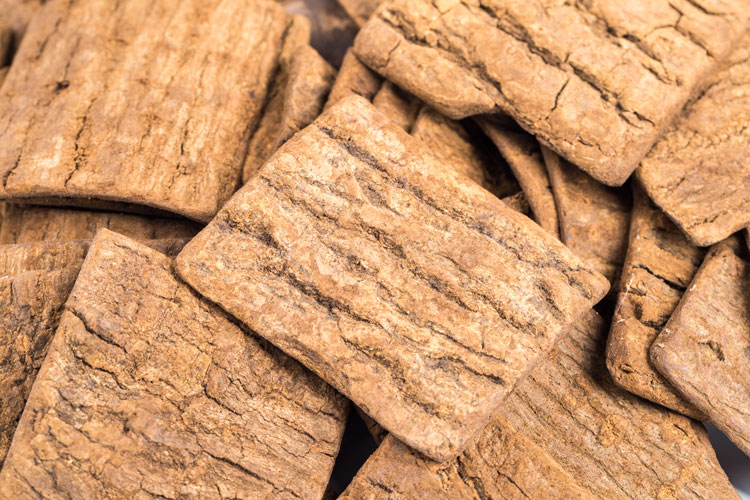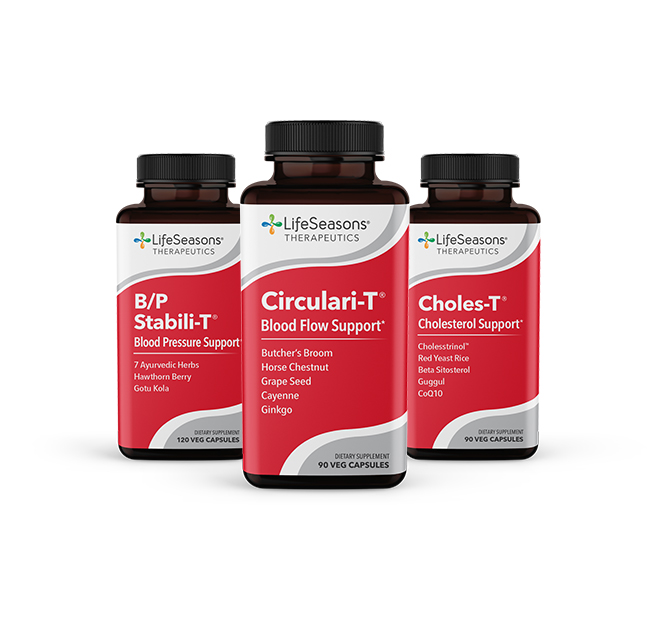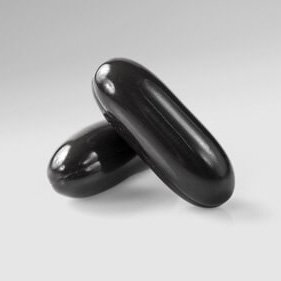BACKGROUND
Ingredient Type: Herb, leaf extract
Also Known As: Gutta-percha tree, Tochu, Chinese rubber tree, Du Zhong, Eucommia ulmoides, Hardy Rubber Tree
Eucommia is an herb that originates from the Chinese rubber tree, also known as Eucommia ulmoides. Its genus is Eucommia, and it is the only genus of the Eucommiaceae family. It grows around 15 m tall. The leaves are arranged and deciduous, with a serrated margin.
It is a plant containing several chemical constituents, including iridoids, lignans, phenolics, flavonoids, steroids, and many other compounds. All the constituents of Eucommia contain several medicinal properties. Eucommia has been used in Chinese Traditional Medicine as a functional food for centuries.

TRADITIONAL USES
Traditionally, Eucommia has been used to support kidney health, the endocrine system, osteoporosis, as well as the cardiovascular system. The constituents of Eucommia have supportive, medicinal properties, including as an anti-allergen, anticancer, and anti-inflammatory. In China, the tonic herb was noted for its ability to ease musculoskeletal and joint pains associated with both weight and deficient conditions. It also is known to contain antioxidant, anti-aging, and neuroprotective properties. Eucommia has been used to enhance overall health and has been recognized as one of the most significant therapeutic agents in support of endocrine and skeletal health (13).
Alternative medicine practitioners in the West used Eucommia to promote longevity and increase strength and vitality. Eucommia was also utilized as an adaptogen and relaxant. Medicinal value could be observed in strengthening bones, tendons, treating osteoporosis, arthritis as well as endocrine and reproductive related conditions such as calming the fetus, prevention of miscarriage and premature ejaculation.
On the East, Eucommia was utilized mainly for the Kidney and Liver meridians, supporting Qi which is known to tonify both organs, resulting in strengthening of the sinews, bones, circulation and Qi. Similar to the West, some of the medicinal uses include fortifying bones, sinews, fatigue, resolution of genitourinary conditions, promotion of circulation, sexual tonic, as well as healing of damaged tissues and the reduction of high blood pressure.
Science-Backed Evidence
The Anti-Diabetic Benefits of Eucommia
Diabetes is one of the more common chronic diseases in developed countries. With diabetes, the body becomes unable to make enough insulin required. Diabetes is not just a single disease but is associated with many other serious health complications, including kidney disease, vision loss, and heart disease. One of the most common types of diabetes is type 2 diabetes. Many people rely on medicines and insulin throughout their life. However, many people believe that herbs and natural remedies are most beneficial for diabetes. Eucommia is one of those herbs that supports diabetes and has been found to relieve many other complications associated with diabetes.
In a study, Eucommia ulmoides Oliver leaf extract was used to analyze the antioxidant effects in mice with type 2 diabetes. This experiment went on for around 6 weeks where the extract of Eucommia was equivalent to 1% dried the whole leaf of Eucommia, which was given in the diet to the mice. The results analyzed revealed that the Eucommia supplement was able to enhance plasma paraoxonase activity, while decreasing blood glucose concentrations when compared to the control group. Higher activities of catalase (CAT), glutathione peroxidase (GSH-Px), and erythrocyte superoxide dismutase (SOD) were also observed in the group supplemented with Eucommia. However, the activity of glutathione reductase (GR) was almost similar between both the treatment and control groups. The results analyzed, yielded that supplementation of Eucommia lowered lipid peroxide and hydrogen peroxide levels in the liver, erythrocytes, and kidney. The conclusion followed that Eucommia is one of the significant therapeutic agents with antioxidant activities for the management and prevention of type 2 diabetes (1).
According to a study, Eucommia bark was used to analyze the effect on the treatment of diabetic nephropathy (DN). For this purpose, the activity of Eucommia was observed on renal dysfunction in type 1-like diabetic rats. In this study, type 1-like diabetes was induced through the administration of Streptozotocin (STZ). Western blot analysis was used to investigate any associated biochemical changes in the affected kidney cells and tissues. Eucommia was given to STZ-diabetic rats for 20 days, at a dosage of 1 g/kg/day. Results showed a decrease in the plasma levels of blood urea nitrogen and creatinine. An improvement in renal fibrosis was also observed. However, there was no significant change in plasma glucose. In STZ-diabetic rats, Du-Zhong (Eucommia) also reduced the increased phosphorylation of Smad2/3. However, the hyperglycemia-induced overproduction of activators of transcription 3 and signal transducers was not reversed with Eucommia in the diabetic kidney. It was concluded that Eucommia is an active novel agent that can be potentially used as a treatment for patients exhibiting diabetic neuropathy in the future (2).
The anti-diabetic properties of Eucommia were analyzed by using a diabetic model in rats. In this study, the methanol extracts of the Ramulus, Cortex, and Folium parts of Eucommia ulmoides were used. With the use of the extracts of the Folium and Cortex, the elevated blood glucose levels in diabetic rats brought on by alloxan and streptozotocin were found to be greatly controlled, along with a pronounced gain in body weight was demonstrated. The treatment with the folium extracts considerably increased the blood insulin levels that had been decreased by the streptozotocin pretreatment. The extracts of Cortex and Folium showed a considerable inhibitory effect on the glucose levels during the glucose tolerance test as well. Additionally, the Cortex and Folium extracts significantly were found to reduce the elevated blood pressure levels in the diabetic rats (3).
Eucommia and Obesity
Obesity, similar to diabetes, can lead to other comorbidities or illness. The excessive accumulation of fat in the body is the root cause of obesity, and its ratio has been increasing abruptly since 1999. There was a little time between 2009 to 2012 when the rate of obesity paused temporarily, but now it has been predicted that it will be the leading problem by 2030 in the USA amongst young adults. Several studies indicate that exercise and diet are the most effective ways to prevent obesity. However, Eucommia has proved to be a significant alternative with anti-obesity properties.
According to a study, rats were used to analyze the potential benefits of Eucommia bark, including its anti-metabolic syndrome and anti-obesity activity. In this study, a metabolic syndrome-like rat model was used. The subjects were fed with a 35% high-fat diet (HFD). Ten groups were made of 80 rats that were analyzed over a period of 3 months. Results showed anti-obesity activity as the body weight stopped increasing. Moreover, Eucommia leads to increased plasma levels of NEFA and TAG. Also, the suppression of TNF-α levels and plasma resistin and an increase in plasma adiponectin levels were observed. PCR studies analyzed that Eucommia leaf has the tendency to enhance metabolic function across various organs, such as decreasing the production of ATP (white adipose tissue), enhancing the use of ketone bodies (skeletal muscle), and boosting beta-oxidation in the liver. All these effects exert an anti-obesity influence under HFD conditions. This study supports that Eucommia leaf has the ability to stimulate the metabolic function in rats. The regulation of adipocytokines maintains the anti-metabolic syndrome activity in the rat model. It was concluded that Eucommia is highly beneficial in preventing obesity and may be an excellent alternative to support the obesity epidemic (4).
In a study, Eucommia green leaf extract was used to analyze its purported anti-obesity properties. A metabolic syndrome-like clinical model in mice was used in this study in which the subjects were fed by 40% high-fat diet for 4 weeks. Following the treatment period, white adipose tissue weight, body weight, total cholesterol levels, and plasma triglyceride levels were significantly inhibited in the model mice. It was observed that the increase in body weight in the model mouse was suppressed due to Eucommia leaves. The free fatty acid levels were also found to be inhibited by using Eucommia leaf extract. It was concluded that Eucommia leaves have powerful and vital anti-obesity properties (5).
In this study, investigations were made in order to observe levels of obesity the subjects treated with Eucommia ulmoides leaves. The subjects were either given an oral diet high in fat along or a water-based solution containing Eucommia leaf extract. In comparison to the high-fat diet group, the 400 mg/kg Eucommia group’s serum triglyceride levels efficiently declined after 60 minutes. The subjects were then fed a diet that contained 40% beef tallow. These rats were separated into three groups; each group got 10% Eucommia leaf extract powder, 10% E. ulmoides leaf green powder, and 10% Eucommia leaf powder, along with beef tallow. Water and food were given to them at will. In comparison to the rats in the 40% beef tallow group, the visceral fat, body weight, and serum triglyceride levels of the Eucommia extract powder and Eucommia leaf powder groups were all significantly lower after 4 weeks. It was concluded that Eucommia had far better outcomes than the subjects fed high fat diets, as it relates to a decrease in obesity related markers (6).
Eucommia Supports Osteoporosis
Osteoporosis is one of the most complicated diseases that weaken the bones, especially in the back, wrist, and hips. This condition is common in both men and women. One of the more common tell-tale signs of osteoporosis which can lead to further related complications. Low intake of calcium diminishes the density of bone, thus leading to an enhanced risk of fractures. Taking calcium in sufficient form may reduce the risk of osteoporosis. Although not a source of calcium, Eucommia has the ability to aid in relieving bone-related complications through its anti-osteoporotic activity.
In an article, Du-Zhong (Eucommia) was used to identify its properties to treat bone fractures and joint diseases. It was examined through the study whether the Eucommia cortex extract can prevent estrogen deficiency-induced osteoporosis or not. Three-month-old female Sprague–Dawley 80 rats were used and appointed into a sham-operated group (Sham) and five ovariectomies (OVX) subgroups. It was observed that the treatment with Du-Zhong cortex extract at higher doses, such as 300 to 500 mg/kg per day, is highly significant for the treatment of osteoporosis and decreases in biomechanical quality of the femur. The mechanical alterations were connected to some microarchitecture improvements or perhaps the prevention of additional bone mineral density (BMD) loss. There was a significant reduction in skeletal remodeling as seen by the levels of the bone turnover indicators osteocalcin (OC), deoxypyridinoline (DPD), alkaline phosphatase (ALP), and urine Ca and P excretions. This dose of Eucommia was found to prevent a total BMD decrease in the femur. Also, there was a significant reduction in connect density, bone volume/tissue volume, trabecula thickness, and trabecula number. Conclusions indicate that Du-Zhong cortex extract treatment has the ability to improve bone biomechanical quality with significant changes in bone mineral density. Eucommia was observed as an alternative treatment for osteoporosis (7).
Du-Zhong (an alternative name for Eucommia) is one of the vital herbs used to treat bone-related diseases in Traditional Chinese Medicine (TCM). In this study, Du-Zhong cortex extract (DZCE) effects were analyzed on disuse-induced osteoporosis. Rats were used to study the effects and were divided into 4 different groups. Hind limb suspension (HLS) was used to treat three groups. Deionized distilled water was given to the HLS group and control group, while DZCE (300 mg/kg/day) and alendronate (2.0 mg/kg/day) for 6 days were given to two other groups. An assay of biochemical markers, dual-energy X-ray absorptiometry, and three-point bending test were used to analyze the effect on turnover, bone mass, and strength. Additionally, microCT analysis was used to assess trabecular bone microarchitecture. A significant decrease was observed in the levels of bone turnover markers as well as bone loss induced by HLS. Also, there were noted changes in phosphorus and urinary calcium. The biomechanical strength of bone was also enhanced by the treatment of Du-Zhong. The data suggests that disuse-induced osteoporosis was prevented by the administration of Du-Zhong cortex extract through the regulation of bone metabolism. Based on the results, it can be concluded that Du-Zhong can be used as a therapeutic agent to prevent disuse-induced osteoporosis (8).
Eucommia Helps with Hypertension
Hypertension, also known as high blood pressure, is when blood pressure levels are considered higher than normal. Normal blood pressure is considered 120/80 mmHg. Depending on daily activities, blood pressure can change throughout the day. However, consistently high blood pressure or chronic hypertension can lead to further cardiovascular complications if not addressed. Elevated blood pressure can be a response due to kidney disease, diabetes, long-term kidney infections, obstructive sleep apnea, and glomerulonephritis. It can also be a result of obesity, anxiety, as well as genetic factors. Eucommia has been found to be scientifically effective in controlling elevated blood pressure.
In an in-vivio study, anti-hypertensive fractions of Eucommia were observed in spontaneously hypertensive rats (SHRs). Sprague–Dawley (SD) rats and SHRs were given Eucommia ulmoides lignans (EuL) and Eucommia ulmoides iridoids (EuI). Their blood pressures were then analyzed. The colorimetric method analyzed the plasma level of nitric oxide (NO). Similarly, radioimmunoassay measured plasma concentration levels of angiotensin II (Ang II), as well as renin activity (RA) in. However, in vitro, EuL was used for rat mesenteric artery, and vessel relaxation responses were analyzed. Results analyzed that Eucommia ulmoides lignans (EuL) reduced the blood pressure of both SD rats. However, Eucommia ulmoides iridoids (EuI) failed to influence the blood pressure in both rats, although the mesenteric artery was noted relaxed by EuL. The effect on endothelium, however, was no different in the perfusion experiment. The combo of EuL and EuI showed no synergistic effect. The plasma levels of nitric oxide in spontaneously hypertensive rats were increased as it was treated with EuL 300 mg/kg two times per day. Overall, it was concluded that Eucommia ulmoides lignans (EuL) showed efficiency in its ability to decrease elevated blood pressure, through its anti-hypertensive properties (9).
SAFETY
Interactions
Studies have shown that Eucommia supports diabetes, high blood pressure, obesity, etc., However, if an individual takes a medication such as diabetic medication, high blood pressure pills, anticoagulants, antiplatelets, or thrombolytics, he/she should never take Eucommia, as there are severe drug interactions of Eucommia with these medications (10). For instance, a person used to take metformin (Glucophage), an antidiabetic medication while taking Du-Zhong, and the sugar level dropped too much, it could potentially create a life-threatening condition.
It is instead recommended that you consult with your healthcare professional to discuss if taking Eucommia is beneficial for you, even in the presence of taking such noted medications.
Potentially interactive medications:
Diabetic: Amaryl, DiaBeta, Diabinese, Avandia, Glucophage, Actos, and Glucotrol (11).
Hypertension: benazepril (Lotensin), captopril (Capoten), enalapril (Vasotec), fosinopril (Monopril), lisinopril (Prinivil, Zestril), moexipril (Univasc), perindopril (Aceon), quinapril (Accupril), Calcium channel blockers, and Vasodilators.
Anti-Coagulants: dabigatran (Pradaxa), apixaban (Eliquis), rivaroxaban (Xarelto), warfarin (Coumadin), Aspirin, clopidogrel (Plavix), prasugrel (Effient), and ticagrelor (Brilinta).
Side-Effects
Research has shown a few adverse effects, including dizziness, moderately severe headaches, the onset of a cold, and edema (12).
References
- Park, S. A., Choi, M. S., Jung, U. J., Kim, M. J., Kim, D. J., Park, H. M., … & Lee, M. K. (2006). Eucommia ulmoides Oliver leaf extract increases endogenous antioxidant activity in type 2 diabetic mice. Journal of medicinal food, 9(4), 474-479.
- Niu, H. S., Liu, I. M., Niu, C. S., Ku, P. M., Hsu, C. T., & Cheng, J. T. (2016). Eucommia bark (Du-Zhong) improves diabetic nephropathy without altering blood glucose in type 1-like diabetic rats. Drug design, development and therapy, 10, 971.
- Hong, N. D., Rho, Y. S., Won, D. H., Kim, N. J., & Cho, B. S. (1987). Studies on the anti-diabetic activity of Eucommia ulmoides Oliver. Korean Journal of Pharmacognosy, 18(2), 112-117.
- Fujikawa, T., Hirata, T., Wada, A., Kawamura, N., Yamaguchi, Y., Fujimura, K., … & Nishibe, S. (2010). Chronic administration of Eucommia leaf stimulates metabolic function of rats across several organs. British Journal of Nutrition, 104(12), 1868-1877.
- Hirata, T., Kobayashi, T., Wada, A., Ueda, T., Fujikawa, T., Miyashita, H., … & Nohara, T. (2011). Anti-obesity compounds in green leaves of Eucommia ulmoides. Bioorganic & Medicinal Chemistry Letters, 21(6), 1786-1791.
- Ando, C., Kobayashi, T., Tsukamoto, S., Hirata, T., Yamaguchi, Y., & Ueda, T. (2007, July). Anti-obesity effects of Eucommia ulmoides leaves. In International Symposium on Eucommia ulmoides(Vol. 1, No. 1, pp. 63-66). Japanese Society of Eucommia.
- Zhang, R., Liu, Z. G., Li, C., Hu, S. J., Liu, L., Wang, J. P., & Mei, Q. B. (2009). Du-Zhong (Eucommia ulmoides Oliv.) cortex extract prevent OVX-induced osteoporosis in rats. Bone, 45(3), 553-559.
- Pan, Y., Niu, Y., Li, C., Zhai, Y., Zhang, R., Guo, X., & Mei, Q. (2014). Du-zhong (Eucommia ulmoides) prevents disuse-induced osteoporosis in hind limb suspension rats. The American journal of Chinese medicine, 42(01), 143-155.
- Luo, L. F., Wu, W. H., Zhou, Y. J., Yan, J., Yang, G. P., & Ouyang, D. S. (2010). Antihypertensive effect of Eucommia ulmoides Oliv. extracts in spontaneously hypertensive rats. Journal of Ethnopharmacology, 129(2), 238-243.
- Murakami, S., Tasaka, Y., Takatori, S., Tanaka, A., Kawasaki, H., & Araki, H. (2018). Effect of Eucommia ulmoides leaf extract on chronic dextran sodium sulfate-induced colitis in mice. Biological and Pharmaceutical Bulletin, 41(6), 864-868.
- Ahn, H. Y., Cho, J. H., Nam, D., Kim, E. J., & Ha, I. H. (2019). Efficacy and safety of Cortex Eucommiae (Eucommia ulmoides Oliver) extract in subjects with mild osteoarthritis: Study protocol for a 12-week, multicenter, randomized, double-blind, placebo-controlled trial. Medicine, 98(50).
- Luo, D., Or, T. C., Yang, C. L., & Lau, A. S. (2014). Anti-inflammatory activity of iridoid and catechol derivatives from Eucommia ulmoides Oliver. ACS chemical neuroscience, 5(9), 855-866.
He, X., Wang, J., Li, M., Hao, D., Yang, Y., Zhang, C., … & Tao, R. (2014). Eucommia ulmoides Oliv.: ethnopharmacology, phytochemistry and pharmacology of an important traditional Chinese medicine. Journal of ethnopharmacology, 151(1), 78-92.









